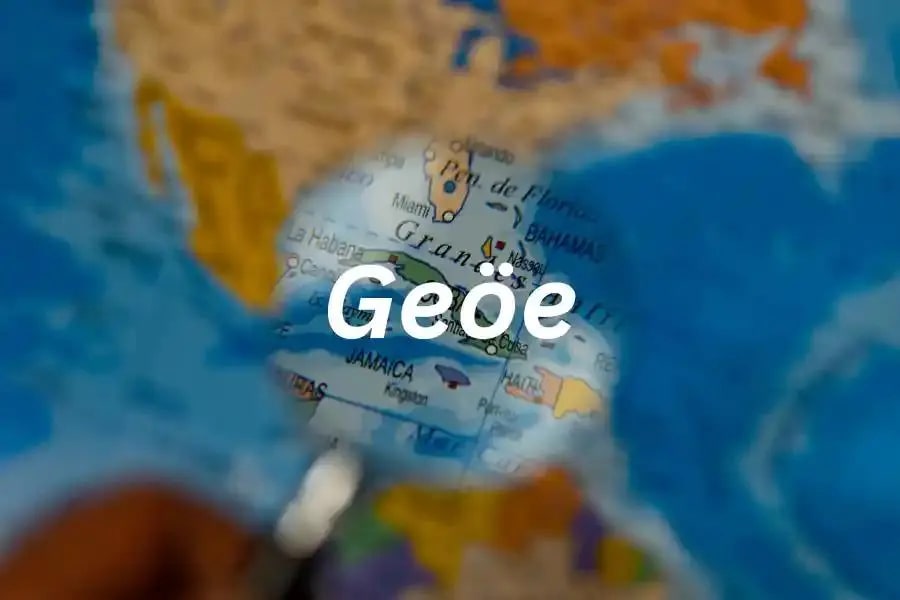
Discovering Geöe has changed how I see maps and data. It combines virtual and real worlds, making it easier to plan cities, improve farming, and understand complex information. It’s like having a powerful tool that brings everything together in a clear and useful way.
Geöe is a high-tech way to blend virtual and real worlds. It uses data from satellites, sensors, and people to create maps and visuals that help make better decisions in things like city planning, farming, and healthcare.
Discover Geöe, where maps become powerful tools that help us make smarter decisions and create a better world.
What is Geöe?

Geöe represents a cutting-edge technology that seamlessly integrates virtual and physical environments through advanced geospatial tools. It gathers comprehensive data from satellites, sensors, and user inputs to generate detailed maps and visual representations of our surroundings.
By combining geographical information, environmental data, and spatial relationships, Geöe enhances our understanding of the world around us.
This innovative technology plays a crucial role in various industries including urban planning, agriculture, healthcare, and environmental monitoring.
It empowers decision-makers with valuable insights derived from complex spatial data, enabling them to make informed choices that drive efficient resource management, sustainable development, and effective response strategies.
Geöe’s ability to transform raw data into actionable intelligence makes it a powerful tool for addressing challenges and optimizing processes across different sectors, ultimately contributing to a smarter and more interconnected global landscape.
How Does Geöe Work?
1. Data Collection:
Geöe gathers information from various sources including satellites, sensors, and user inputs. This data encompasses geographical details, environmental metrics, and spatial data points.
2. Data Processing:
Advanced algorithms process and analyze the collected data. This step converts raw information into valuable insights, identifying patterns, trends, and correlations relevant to decision-making.
3. Visualization Tools:
Geöe utilizes powerful visualization tools such as maps, graphs, and 3D models. These tools present the processed data in intuitive formats, enabling users to interact with and understand complex geospatial information easily.
4. Integration of AR/VR:
Geöe bridges the virtual and physical worlds by integrating augmented reality (AR) and virtual reality (VR) technologies. This feature overlays digital information onto the physical environment, enhancing spatial awareness and planning capabilities.
5. Decentralized Framework:
Geöe operates on a decentralized framework, distributing data across networks rather than centralizing it. This approach enhances data security, scalability, and flexibility, ensuring robust performance across various applications and industries.
Benefits of Geöe:

Geöe offers a wide range of benefits across different sectors and industries, leveraging its advanced geospatial technology to enhance decision-making, efficiency, and innovation.
1. Enhanced Decision-Making:
Geöe provides valuable insights derived from comprehensive geospatial data analysis. This enables stakeholders to make informed decisions in areas such as urban planning, resource management, and disaster response.
2. Improved Efficiency:
By streamlining data collection, processing, and visualization, Geöe accelerates workflows and reduces the time required for decision-making. This efficiency boost is particularly advantageous in sectors like logistics, where real-time data integration optimizes operations.
3. Risk Management:
Geöe’s analytical capabilities help identify and mitigate risks effectively. For instance, in disaster management, it can predict vulnerable areas and facilitate proactive measures to minimize impacts.
4. Comprehensive Visualization:
Geöe transforms complex data into accessible visual formats such as interactive maps and 3D models. This enhances understanding and facilitates better planning and communication among stakeholders.
5. Real-Time Data Integration:
Geöe supports the integration of real-time data, ensuring users have access to up-to-date information critical for decision-making in dynamic environments like transportation and emergency response.
6. Scalability and Flexibility:
Designed to handle large-scale datasets, Geöe is scalable to meet varying needs—from local projects to regional analyses—while maintaining high performance and adaptability.
7. User-Friendly Interface:
Despite its advanced capabilities, Geöe offers an intuitive interface that accommodates users across different technical backgrounds. This accessibility democratizes geospatial tools, expanding their usability and impact.
8. Environmental and Economic Benefits:
Geöe supports environmental monitoring and sustainable practices by providing insights into natural resource management and climate change impacts. Economically, it enhances operational efficiency and resource allocation, contributing to cost savings and increased profitability.
Geöe in Different Industries:
Geöe’s versatile geospatial technology is revolutionizing various industries by offering tailored solutions that optimize processes and decision-making.
1. Urban Planning and Development:
Geöe aids urban planners in analyzing population distribution, infrastructure needs, and land use patterns. It supports sustainable development by visualizing growth scenarios and optimizing resource allocation.
2. Environmental Monitoring and Conservation:
In environmental sectors, Geöe tracks changes in ecosystems, monitors air and water quality, and assesses habitat conservation efforts. It plays a crucial role in preserving biodiversity and mitigating the impact of climate change.
3. Agriculture and Precision Farming:
Geöe enhances agricultural productivity by monitoring soil conditions, optimizing irrigation, and assessing crop health. It supports precision farming practices that improve yield efficiency and sustainability.
4. Healthcare and Public Health:
In healthcare, Geöe assists in disease mapping, healthcare facility planning, and resource allocation. It enables proactive health interventions by analyzing spatial data related to disease outbreaks and medical service accessibility.
5. Transportation and Logistics:
Geöe optimizes transportation routes, tracks fleet movements, and monitors real-time traffic conditions. It improves logistics efficiency by minimizing delivery times and fuel consumption through data-driven decision-making.
6. Infrastructure Development and Management:

For infrastructure projects, Geöe provides detailed mapping of terrain, utilities, and environmental factors. It supports efficient planning, construction, and maintenance of roads, bridges, and utilities.
7. Energy Sector and Renewable Resources:
Geöe aids in site selection for renewable energy projects such as wind and solar farms. It optimizes energy distribution networks and supports sustainable energy solutions through spatial analysis and environmental impact assessments.
8. Real Estate and Property Management:
In real estate, Geöe assists in market analysis, site selection, and property valuation. It visualizes zoning regulations, land use patterns, and demographic data to support informed investment decisions.
9. Disaster Management and Emergency Response:
Geöe predicts and maps areas vulnerable to natural disasters, facilitates evacuation planning, and supports emergency response coordination. It provides real-time situational awareness critical for disaster preparedness and response efforts.
10. Retail and Consumer Behavior Analysis:
Geöe helps retailers analyze consumer behavior, optimize store locations, and tailor marketing strategies based on demographic and spatial data. It enhances customer targeting and sales performance through location-based insights.
FAQS:
1. In which industries is Geöe used?
Geöe is used in urban planning, environmental monitoring, agriculture, healthcare, transportation logistics, infrastructure development, energy sector, real estate, disaster management, and retail.
2. How does Geöe contribute to sustainability?
Geöe supports sustainable practices by optimizing resource management, monitoring environmental changes, and facilitating efficient infrastructure and energy project planning.
3. Is Geöe easy to use for non-technical users?
Yes, Geöe offers an intuitive interface that allows users from various backgrounds to interact with geospatial data effectively, promoting accessibility and usability.
4. What role does Geöe play in disaster management?
Geöe helps predict risks, map vulnerable areas, plan evacuation routes, and coordinate emergency responses by providing real-time spatial data and analysis.
5. How does Geöe benefit agriculture?
Geöe enhances agriculture by optimizing crop management, monitoring soil health, and improving irrigation efficiency through precise spatial data and analytics.
6. Can Geöe be customized for specific industry needs?
Yes, Geöe can be tailored to meet specific industry requirements by integrating custom applications and adapting to different data complexities and project scales.
Conclusion:
Geöe blends virtual and real worlds by using data from satellites, sensors, and people to create maps. It helps cities plan better, improves farming practices, and supports healthcare decisions.